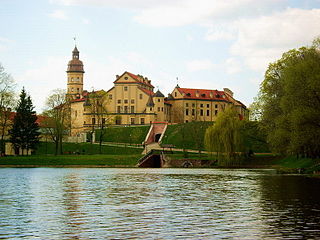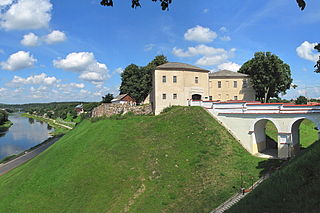 W
WBiržai Castle is a castle in Biržai, Lithuania. Construction of the earth bastion-type castle started in 1586 by the order of Krzysztof Mikołaj "the Lightning" Radziwiłł. In 1575, preparing for this construction, a dam was built on the Agluona and Apaščia rivers at their confluence, and the artificial Lake Širvėna, covering about 40 km², was created. Major castle building works were finished in 1589.
 W
WBrest Castle evolved in the course of several centuries from the Slavonic fortified settlement Berestye that had appeared at the turn of the 10th and 11th centuries at the confluence of the Mukhavets River into the Bug River, amid islands, formed by the rivers. It was re-built several times after numerous fires and sieges, was destroyed in the course of construction of the Brest Fortress in the 19th century.
 W
WGediminas' Tower is the remaining part of the Upper Castle in Vilnius, Lithuania.
 W
WKamianets-Podilskyi Castle is a former Ruthenian-Lithuanian castle and a later three-part Polish fortress located in the historic city of Kamianets-Podilskyi, Ukraine, in the historic region of Podolia in the western part of the country. Its name is attributed to the root word kamin', from the Slavic word for stone.
 W
WKaunas Castle is a medieval castle in Kaunas, the second-largest city in Lithuania. Archeological evidence suggests that it was originally built during the mid-14th century, in the Gothic style. Its site is strategic – a rise on the banks of the Nemunas River near its confluence with the Neris River. At the beginning of the 21st century, about one-third of the castle was still standing.
 W
WKobryn castles were a complex of wooden defense and administrative structures that existed in the city of Kobryn in the 16th–18th centuries. Presumably, the first Kobryn castle (detinets) was founded in the 11th century by the heirs of the Kiev prince Izyaslav on the island at the confluence of the Kobrinka and Mukhavets rivers. The remaining earth embankments were dismantled in the 1880s when laying the Moscow–Warsaw chaussee.
 W
WKremenets Castle is situated in the city of Kremenets, Ukraine. The castle was built of limestone on a steep hill. The keep located on its west side, and its width was 65 metres (213 ft) and length of 135 metres (443 ft). All the elevation was surrounded by a tall stone wall, and in the earlier ages of the 13th century wood as building material was used instead.
 W
WKreva Castle is the ruins of a major fortified residence of the Grand Dukes of Lithuania in the village of Kreva, Belarus. The village lies 220 metres (720 ft) above sea level.
 W
WLida Castle is a historic, medieval castle in Lida, Grodno Region, western Belarus.
 W
WLutsk Castle, also locally known as Lubart's Castle or Upper Castle, began its life in the mid-14th century as the fortified seat of Gediminas' son Liubartas (Lubart), the last ruler of united Galicia-Volhynia. It is the most prominent landmark of Lutsk, Ukraine and as such appears on the 200 hryvnia bill.
 W
WMedininkai Castle, a medieval castle in Vilnius district, Lithuania, was built in the first half of the 14th century. The defensive perimeter of the castle was 6.5 hectares; it is the largest enclosure type castle in Lithuania. It was built on plain ground and was designed for flank defence. The rectangular castle's yard covered approximately 1.8 hectares and was protected by walls 15 metres high and 2 metres thick. The castle had 4 gates and towers. The main tower (donjon), about 30 metres high, was used for residential quarters. Medininkai was first mentioned in 1392. The castle was badly damaged by a major fire in the late 15th century. Because of increased use of firearms, this type of castle was no longer suited for defensive purposes and was later used as a residence. During the 17th–18th centuries it was reorganized into a farm and a bakery. After the castle's restoration, its museum currently exhibits large collection of items made from silver by artisans of the Grand Duchy of Lithuania, and collection of hunting trophies and hunting knives of President Algirdas Brazauskas.
 W
WThe Mir Castle Complex is a historic fortified castle and a UNESCO World Heritage site in Belarus. It is located in the town of Mir, in the Kareličy District of the Hrodna voblast, at 53°27′4.46″N 26°28′22.80″E, 29 kilometres (18 mi) north-west of another World Heritage site, Niasviž Castle. Mir Castle Complex is 164 metres (538 ft) above sea level. Erected in the 16th century in the late Polish Gothic style, it is one of the few remaining architectural monuments of the former Polish–Lithuanian Commonwealth in contemporary Belarus.
 W
WNiasviž Castle or Nesvizh Castle is a residential castle of the Radziwiłł family in Niasviž, Belarus. It is 183 metres (600 ft) above sea level.
 W
WThe New Castle in Grodno, Belarus is a royal palace of Augustus III of Poland and Stanisław August Poniatowski where the famous Grodno Sejm took place in 1793. New Grodno Castle is 116 metres (381 ft) above sea level.
 W
WThe Old Grodno Castle originated in the 11th century as the seat of a dynasty of Black Ruthenian rulers, descended from a younger son of Yaroslav the Wise of Kiev.
 W
WThe Tykocin Royal Castle is a 15th-century castle located on the right bank of the river Narew in Tykocin, Poland. It fell into ruin in the 18th century and its reconstruction began in 2002.
 W
WThe Vilnius Castle Complex is a group of cultural, and historic structures on the left bank of the Neris River, near its confluence with the Vilnia River, in Vilnius, Lithuania. The buildings, which evolved between the 10th and 18th centuries, were one of Lithuania's major defensive structures.